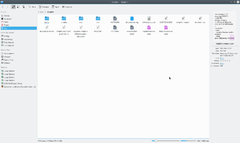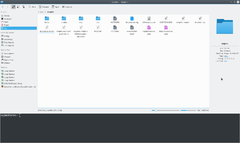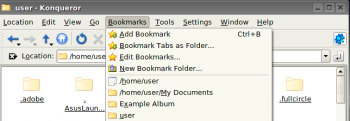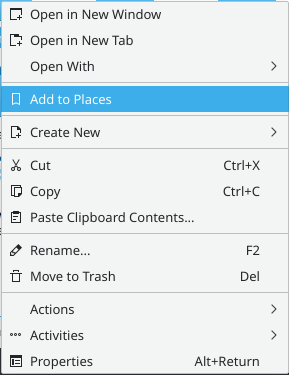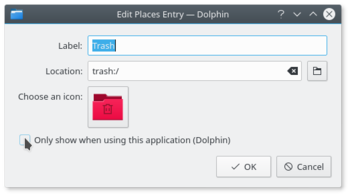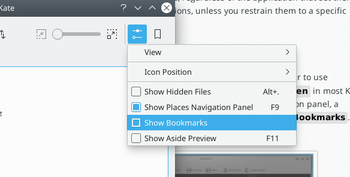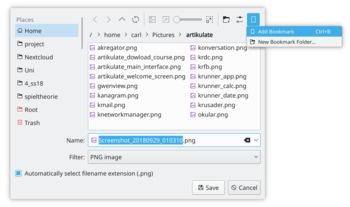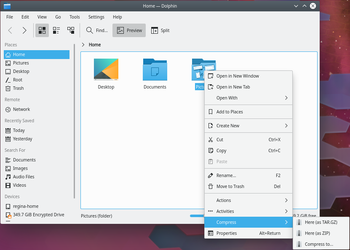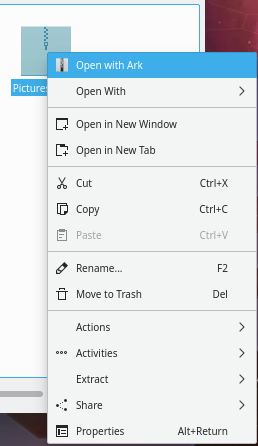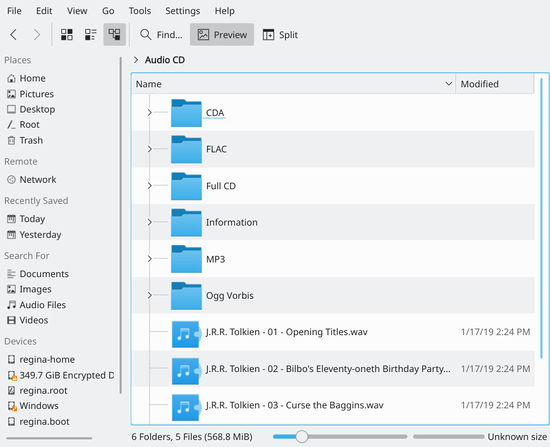Dolphin/File Management/zh-cn: Difference between revisions
Updating to match new version of source page |
No edit summary |
||
| (10 intermediate revisions by one other user not shown) | |||
| Line 1: | Line 1: | ||
<languages /> | <languages/> | ||
<span id="Discover Dolphin"></span> | <span id="Discover Dolphin"></span> | ||
=== Dolphin 或是 Konqueror? === | === Dolphin 或是 Konqueror? === | ||
Dolphin | Dolphin 是 Plasma Workspace 的文件管理程序。 它被设计为易于使用但功能强大。 | ||
[ | [[Special:myLanguage/Konqueror|Konqueror]]是 KDE 2 和 3 的默认文件管理器,并且在现在对喜爱它的界面的人仍然可用。它是浏览器,是文件管理器,媒体浏览器和更多。对于文件管理,它使用 Dolphin KPart,因此具有 Dolphin 的所有功能。 | ||
==发掘 Dolphin== | ==发掘 Dolphin== | ||
第一部分将带您预览 '''Dolphin'''。第二部分涉及不同类型的书签的概念。第三部分讨论文件管理。最后,我们来看'更酷的东西' | |||
第一部分将带您预览 '''Dolphin'''。第二部分涉及不同类型的书签的概念。第三部分讨论文件管理。最后,我们来看'更酷的东西'。图片是可点击的——你可以点击图片查看大图。 | |||
===介绍 Dolphin=== | ===介绍 Dolphin=== | ||
| Line 15: | Line 16: | ||
我会展示如何用 ''Dolphin''' 完成一般的文件管理任务和定制它满足你的需要。 | 我会展示如何用 ''Dolphin''' 完成一般的文件管理任务和定制它满足你的需要。 | ||
[[Image:Dolphin_Plasma5_thumbnail.png|thumb|240px|center]] | [[Image:Dolphin_Plasma5_thumbnail.png|thumb|240px|center]] | ||
当我们从 [[Special:myLanguage/Plasma/Kickoff|Kickoff菜单]]里打开 '''Dolphin''',它首先显示的是开始目录- 默认是 [[Special:myLanguage/Glossary#Home_Directory|主文件夹]]。 | |||
你可以通过点击文件夹或文件来打开它们(这可以通过<menuchoice>系统设置</menuchoice> → <menuchoice>工作区行为</menuchoice> → <menuchoice>常规行为</menuchoice>更改为双击打开(在更老的版本中,它位于<menuchoice>系统设置</menuchoice> → <menuchoice>输入设备</menuchoice> → <menuchoice>鼠标选项</menuchoice> ))。 | |||
要选择和取消选择文件/文件夹,悬停鼠标指针到图标上,点击出现的+号来选择,点-号来取消选择。像是这样: | 要选择和取消选择文件/文件夹,悬停鼠标指针到图标上,点击出现的+号来选择,点-号来取消选择。像是这样: | ||
| Line 29: | Line 28: | ||
多个被选中的文件看起来是这样的: | 多个被选中的文件看起来是这样的: | ||
[[Image:Dolphin folder hovered deselect.png|thumb|240px|center]] | [[Image:Dolphin folder hovered deselect.png|thumb|240px|center]] | ||
'''创建新文件夹''':你可以在当前活动的目录下用<menuchoice> | '''创建新文件夹''':你可以在当前活动的目录下用<menuchoice>菜单(右键)</menuchoice> → <menuchoice>创建新文件夹</menuchoice> ,或快捷键 <keycap>F10</keycap>。 | ||
'' | '''标签''':'''Dolphin''' 支持多标签浏览。 举例来说,可以通过 <menuchoice>文件</menuchoice> → <menuchoice>新标签</menuchoice> 打开一个新标签(如果您启用了菜单栏), 也可以通过 <keycap>Ctrl + T</keycap> 或鼠标中键点击文件夹图标和导航按钮(前进/后退)。 | ||
{{ | {{提示|从 KDE 4.7 开始,Dolphin 的菜单栏是隐藏的,但仍然可以访问和恢复。 如果您希望显示菜单栏, 你可以通过<menuchoice>设置</menuchoice> → <menuchoice>显示菜单栏</menuchoice> 或按压<keycap>Ctrl + M</keycap>快捷键来启用它。}} | ||
点击如何文件夹的时候都会默认启动 '''Dolphin'''。也能在 [[Special:myLanguage/Plasma/Kickoff|Kickoff 菜单]]里启动它. | 点击如何文件夹的时候都会默认启动 '''Dolphin'''。也能在 [[Special:myLanguage/Plasma/Kickoff|Kickoff 菜单]]里启动它. | ||
== | ==用户界面== | ||
== | == 导航栏 == | ||
'''Dolphin''' | '''Dolphin''' 整合了新概念以一种更快速和更准确的方法使用导航栏:新的面包屑(breadcrumb)导航栏。与传统的显示完整的路径不同,仅从「地址」之一开始的导航点作为按钮显示。点击那些按钮之一你能直接进入这个文件夹。通过这种方式你能快速的从一个子文件夹到达父文件夹。 | ||
在代表文件夹的按钮之间有一个小的箭头也是个可点击的按钮。点击这个箭头你能看到一份列表,列表里是跟你现在这个目录同级的所有子目录(译者注:这说的是你点当前这个文件夹按钮前的「箭头」的情况,其实列表显示的就是「箭头」前那个文件夹的所有子文件夹),使你能快速改变目录。 | 在代表文件夹的按钮之间有一个小的箭头也是个可点击的按钮。点击这个箭头你能看到一份列表,列表里是跟你现在这个目录同级的所有子目录(译者注:这说的是你点当前这个文件夹按钮前的「箭头」的情况,其实列表显示的就是「箭头」前那个文件夹的所有子文件夹),使你能快速改变目录。 | ||
| Line 51: | Line 49: | ||
同样也有一个显示完整路径的经典导航栏。要使用此样式,您可以右键单击位置栏并选择<menuchoice>显示完整路径</menuchoice>。如果您希望位置栏可编辑,请触发键盘快捷键 <keycap>Ctrl + L</keycap> 或选择 <menuchoice> 设置</menuchoice> → <menuchoice>位置栏</menuchoice> → <menuchoice>可编辑位置</menuchoice>。通过单击面包屑样式中最后一个显示文件夹旁边的空间,您也可以切换到可编辑的位置栏。如果选择了可编辑样式,则会在位置栏的末尾显示一个复选标记。此复选标记是一个按钮,可用于更改回面包屑样式。当然也能用菜单和键盘快捷键。 | |||
== 拆分视图 == | == 拆分视图 == | ||
'''Dolphin''' | '''Dolphin''' 能够拆分当前文件夹视图并产生出两个彼此相邻的文件夹视图,参考[[:wikipedia:Midnight Commander|Midnight Commander]] 或 [[Special:myLanguage/Krusader|Krusader]]。这种浏览方式非常适合从一个文件夹复制或移动文件到另一个文件夹。 | ||
[[Image:Dolphin split view.png|thumb|350px|center]] | [[Image:Dolphin split view.png|thumb|350px|center]] | ||
<div class="mw-translate-fuzzy"> | |||
你能用<menuchoice>查看 -> 拆分</menuchoice> (键盘快捷键<keycap>F3</keycap>)拆分视图。要变回到只有一个文件夹视图,你可以点<menuchoice>查看 -> 关闭</menuchoice>。小图标会显示哪个视图会被关闭。取决于当前激活的视图,减号会显示在图标的左侧或右侧。激活的视图会被关闭。如果你想用键盘快捷键操作的话,需要知道这点。在工具栏上也有一个用来拆分和关闭视图按钮。这个按钮也会显示减号,所以很容易的能看出来哪个视图会被关闭。 | |||
</div> | |||
<div class="mw-translate-fuzzy"> | |||
当然每个视图都有他自己的导航栏,每个视图也能用不同的视图模式。 | |||
</div> | |||
=== Sorting Files === | === Sorting Files === | ||
<div class="mw-translate-fuzzy"> | |||
默认在现在选择的文件夹内的文件是依字母顺序排序。通过菜单<menuchoice>查看 -> 排序以</menuchoice>修改排序方式。提供如下的排序条件: | |||
</div> | |||
Files may be sorted by the following attributes | Files may be sorted by the following attributes | ||
* | <div class="mw-translate-fuzzy"> | ||
* | * 名字 | ||
* | * 大小 | ||
* | * 日期 | ||
* | * 权限 | ||
* | * 拥有者 | ||
* | * 群组 | ||
* 类型 | |||
* Link Destination | * Link Destination | ||
* | * 路径 | ||
此外排序序列可以用<menuchoice>查看 -> 排序方式 -> 降序</menuchoice>定义,或 <menuchoice>视图 -> 排序方式 -> 文件夹优先</menuchoice>。 | |||
</div> | |||
The sorting method can be changed by selecting <menuchoice>Sort by</menuchoice> from the toolbar and then select <menuchoice>A-Z</menuchoice> or <menuchoice>Z-A</menuchoice>. Additionally you may choose whether folders should be listed first by selecting <menuchoice>Folders First</menuchoice>. | |||
<div class="mw-translate-fuzzy"> | |||
== 视图模式 == | == 视图模式 == | ||
</div> | |||
'''Dolphin''' features three different folder view modes: | '''Dolphin''' features three different folder view modes: | ||
| Line 107: | Line 114: | ||
==== View as Icons ==== | ==== View as Icons ==== | ||
<div class="mw-translate-fuzzy"> | |||
在''"图标"''视图模式下每个文件和每个文件夹都用一个图标表示。也可以显示文件的缩略图取代显示图标。这种做法可以通过菜单<menuchoice>查看 -> 预览</menuchoice>或是通过工具栏按钮开启/关闭。文件预览是有大小限制。这个大小限制可以在<menuchoice>设置 -> 配置 Dolphin -> 常规</menuchoice>选项<menuchoice>预览 -> 最大文件大小</menuchoice>自定义。这里也有选项在预览时使用嵌入到文件里的缩略图(比如说mp3文件里的专辑封面)。KDE 4.5中预览通过<menuchoice>设置-> 配置Dolphin -> 常规 -> 预览</menuchoice>选项开启、配置。 | |||
</div> | |||
<div class="mw-translate-fuzzy"> | |||
Dolphin 能够在图标下显示额外的信息。这些信息可以通过<menuchoice>查看 -> 额外信息</menuchoice>启用/关闭。主要来说可以选择的都是能作为排序条件的信息。 | |||
</div> | |||
<div class="mw-translate-fuzzy"> | |||
你能给图标分组来达到更好的预览效果。这个通过<menuchoice>查看 -> 分组显示</menuchoice>启用。现在这些图标都被分组,组和组又被一条以组名为标题的水平线划分开。分组是依据选择的排序方式里的排序条件。 | |||
</div> | |||
[[Image:Dolphin show in groups effect.png|thumb|240px|center]] | [[Image:Dolphin show in groups effect.png|thumb|240px|center]] | ||
=== 细节 === | === 细节 === | ||
| Line 129: | Line 140: | ||
分列 ''"名称''" 总是显示的。点击每个分列的顶部,列表会根据这个分列重新排序。点击分列顶部,分类序列会复原(译者注:靠(#‵′) 为什么我这不会恢复,只会反向再排序一次)。 | 分列 ''"名称''" 总是显示的。点击每个分列的顶部,列表会根据这个分列重新排序。点击分列顶部,分类序列会复原(译者注:靠(#‵′) 为什么我这不会恢复,只会反向再排序一次)。 | ||
<div class="mw-translate-fuzzy"> | |||
自从KDE 4.1后Dolphin能够树形展开显示文件夹。在这种模式下,一个加号的标记符号会在文件夹旁显示。点击标记符号,文件夹就会被展开,所有包含的子文件夹和文件也会显示在列表but they are itenuated.点击标记符号后标记符号会变成减号,再次点击,展开就会被关闭。当然多少的文件夹都能用树形结构。树形视图默认是没启用,可以通过 <menuchoice>设置 -> 配置 Dolphin -> 视图模式 -> 细节 </menuchoice>打开选项<menuchoice>可展开的文件夹</menuchoice>启用。 | |||
</div> | |||
<div class="mw-translate-fuzzy"> | |||
===设置所有文件夹默认的视图属性=== | |||
在<menuchoice>查看 > 调整视图属性</menuchoice>菜单项,你能为所有的文件夹浏览设置默认的任何属性。 | |||
</div> | |||
Under <menuchoice>Control</menuchoice> → <menuchoice>Adjust View Properties</menuchoice> (or under the menu item <menuchoice>View</menuchoice> → <menuchoice>Adjust View Properties</menuchoice> if you have enabled menu bar) you can set any of these attributes to be the default for all folder views. | |||
Under <menuchoice>Control | |||
== 面板 == | == 面板 == | ||
'''Dolphin''' | <div class="mw-translate-fuzzy"> | ||
'''Dolphin''' 包含了多个面板,能通过菜单<menuchoice>查看 -> 面板</menuchoice>激活。每个面板都能放到左侧或右侧dock区域。要移动面板你必须点击面板顶部然后拖放面板。释放鼠标将被放置面板的那个区域会被高亮。面板可以堆叠在其他面板之上。在这种情况下,面板会放入分页标签。 | |||
</div> | |||
<div class="mw-translate-fuzzy"> | |||
在每个面板的标题有两个按钮。接近标题的按钮可以游离(undock)面板。这使得面板成为一个独立的窗口「漂浮」于 '''Dolphin'''上。但窗口还是与 '''Dolphin'''结合的,不能在没有 '''Dolphin'''时显示,不能像普通窗口一样最小化。再次点击按钮,面板可以回复停靠。第二个按钮会关闭面板。 | 在每个面板的标题有两个按钮。接近标题的按钮可以游离(undock)面板。这使得面板成为一个独立的窗口「漂浮」于 '''Dolphin'''上。但窗口还是与 '''Dolphin'''结合的,不能在没有 '''Dolphin'''时显示,不能像普通窗口一样最小化。再次点击按钮,面板可以回复停靠。第二个按钮会关闭面板。 | ||
</div> | |||
=== 非模态窗口(Non Modal Dialogs) === | === 非模态窗口(Non Modal Dialogs) === | ||
| Line 148: | Line 166: | ||
当移动,复制或删除文件/目录,这个对话框甚至会在操作还没完成的时就消失不见。然后一个进度条便出现在屏幕右下角,之后也会消失,如果你想要查看进度你需要点击系统托盘里的一个小的「i」信息图标。 | 当移动,复制或删除文件/目录,这个对话框甚至会在操作还没完成的时就消失不见。然后一个进度条便出现在屏幕右下角,之后也会消失,如果你想要查看进度你需要点击系统托盘里的一个小的「i」信息图标。 | ||
{{Warning | {{Warning|New users who are not used to this way of working (and even experienced users) can get caught out by this, if you are Moving, Copying or Deleting large directories then you need to use the icon to monitor the progress of your operation. | ||
If you don't then any subsequent actions you do, may well use an incomplete file structure resulting in corrupted files. '''You have been warned!'''}} | |||
''' | |||
=== 地址 === | === 地址 === | ||
'''Dolphin''' | <div class="mw-translate-fuzzy"> | ||
'''Dolphin''' 包含了一种被叫做''"地址"''的书签。通过<menuchoice>查看 -> 面板 -> 地址</menuchoice>(键盘快捷键<keycap>F9</keycap>)激活显示在一个面板内。地址的内容跟K菜单 [[Special:myLanguage/Plasma/Kickoff|Kickoff菜单]] 中的''"计算机"''目录一样。 | |||
</div> | |||
点击地址中一个,他就会在当前文件夹视图内打开。右键关联菜单能够编辑「地址」或再次删除它们。同样能临时隐藏个别的条目。 | 点击地址中一个,他就会在当前文件夹视图内打开。右键关联菜单能够编辑「地址」或再次删除它们。同样能临时隐藏个别的条目。 | ||
| Line 168: | Line 185: | ||
=== 信息 === | === 信息 === | ||
<div class="mw-translate-fuzzy"> | |||
信息面板能通过<menuchoice>查看 -> 面板 -> 信息</menuchoice> (键盘快捷键<keycap>F11</keycap>)激活。这个面板显示了当前选择的文件/文件夹或是鼠标光标悬停的文件/文件夹的预览或是图标。一些额外的信息像是文件/文件夹的修改日期或是大小也会同时显示。 | |||
</div> | |||
信息面板提供了给文件评星级,添加注释或标记文件的可能性。这是为桌面提供语义网络特性的语义桌面[[Special:myLanguage/Nepomuk|Nepomuk]]的一种界面。自KDE 4.2后,可以通过搜索「标记」(tags)搜索语义链接。现在的「标记」(tags)仅给了对未来版本的一个展望。 | 信息面板提供了给文件评星级,添加注释或标记文件的可能性。这是为桌面提供语义网络特性的语义桌面[[Special:myLanguage/Nepomuk|Nepomuk]]的一种界面。自KDE 4.2后,可以通过搜索「标记」(tags)搜索语义链接。现在的「标记」(tags)仅给了对未来版本的一个展望。 | ||
<div class="mw-translate-fuzzy"> | |||
[[Image:dolphin_panel.png|thumb|240px|center|信息面板l]] | [[Image:dolphin_panel.png|thumb|240px|center|信息面板l]] | ||
</div> | |||
{{Tip/zh-cn|1=如果你想知道一些文件中缺失的mp3 ID标签(标题,时间。。。),那最有可能是ID3v2标签丢失了。你可以自行添加ID3v2标签,比如用 '''KID3'''。}} | {{Tip/zh-cn|1=如果你想知道一些文件中缺失的mp3 ID标签(标题,时间。。。),那最有可能是ID3v2标签丢失了。你可以自行添加ID3v2标签,比如用 '''KID3'''。}} | ||
| Line 178: | Line 199: | ||
=== 文件夹 === | === 文件夹 === | ||
<div class="mw-translate-fuzzy"> | |||
一个提供文件系统的树形结构的面板能通过 <menuchoice>查看 -> 面板 -> 文件夹 </menuchoice> (键盘快捷键<keycap>F7</keycap>)显示出来。树形结构提供了这样的可能性,点击+和-符号来展开/折叠子文件夹。点击其中之一的文件夹,文件夹的内容就会在当前视图打开。 | |||
</div> | |||
=== | === Terminal === | ||
<div class="mw-translate-fuzzy"> | |||
终端模拟器 [[Special:myLanguage/Konsole|Konsole]] 可以直接在 '''Dolphin''' 里显示,点击<menuchoice>查看 -> 面板 -> 终端</menuchoice> (键盘快捷键<keycap>F4</keycap>)。所以在Dolphin里能直接使用shell命令。这个终端是在当前浏览的文件夹中打开的。<keycap>Shift + F4</keycap> 快捷键在新窗口打开 '''Konsole'''。 | |||
</div> | |||
<div class="mw-translate-fuzzy"> | |||
[[Image:dolphin_terminal.png|thumb|240px|center|带终端的 Dolphin]] | [[Image:dolphin_terminal.png|thumb|240px|center|带终端的 Dolphin]] | ||
</div> | |||
<div class="mw-translate-fuzzy"> | |||
==书签和地址== | ==书签和地址== | ||
KDE3下你能在 '''Konqueror''' 里创建书签,但是他们对其他任何程序都没用。KDE SC 4.x 有着长足的进步变得更灵活了 - 但也不可避免的更复杂了。实际上KDE SC 4有三种类型的'书签',需要区别开来。他们属于不同的文件,各有不同的功能。 | KDE3下你能在 '''Konqueror''' 里创建书签,但是他们对其他任何程序都没用。KDE SC 4.x 有着长足的进步变得更灵活了 - 但也不可避免的更复杂了。实际上KDE SC 4有三种类型的'书签',需要区别开来。他们属于不同的文件,各有不同的功能。 | ||
</div> | |||
KDE Plasma offers two different systems of user-based links to different locations in the file system. One is called ''Places'' and the other one is called ''Bookmarks''. They reside in different files, and have different functions. This offers more flexibility, however, it makes it necessary to learn the differences. | |||
<div class="mw-translate-fuzzy"> | |||
[[Image:Konq3bookmarks.png|350px|thumb|center|KDE3里的Konqueror并不共享书签]] | [[Image:Konq3bookmarks.png|350px|thumb|center|KDE3里的Konqueror并不共享书签]] | ||
</div> | |||
= | <div class="mw-translate-fuzzy"> | ||
首先,有一种只有 '''Konqueror''' 能用的书签-''web 书签''。这些都保存在~/.kde/share/apps/konqueror/bookmarks.xml。其次有一种在'''Dolphin'''里叫做''地址''的书签。这种包括了 '''Dolphin'''文件管理器在内的所有程序都能用到。每次你用 <menuchoice> 文件 > 打开 </menuchoice> 你就会看到这种类型的书签。第三种书签是 ''程序书签 ''。那些书签共享一个文件,而与设置他们的程序无关,对所有程序都可用。随后有更详细的。 | |||
</div> | |||
=== Places in applications === | |||
=== | |||
<div class="mw-translate-fuzzy"> | |||
==="地址"-全系统的导航=== | ==="地址"-全系统的导航=== | ||
</div> | |||
这里是一组默认的 ''地址项 '' - | 这里是一组默认的 ''地址项 '' - | ||
| Line 213: | Line 242: | ||
<div class="mw-translate-fuzzy"> | |||
[[Image:DolphinAdd.png|350px|thumb|center|添加一个书签到地址]] | [[Image:DolphinAdd.png|350px|thumb|center|添加一个书签到地址]] | ||
</div> | |||
| Line 219: | Line 250: | ||
<div class="mw-translate-fuzzy"> | |||
[[Image:OnlyShowIn.png|350px|thumb|center|这个地址项只会在Dolphin里可见]] | [[Image:OnlyShowIn.png|350px|thumb|center|这个地址项只会在Dolphin里可见]] | ||
</div> | |||
<div class="mw-translate-fuzzy"> | |||
如果你读取 ~/.kde4/share/apps/kfileplaces/bookmarks.xml 文件你会看到这个命令的处理结果。 | 如果你读取 ~/.kde4/share/apps/kfileplaces/bookmarks.xml 文件你会看到这个命令的处理结果。 | ||
</div> | |||
<div class="mw-translate-fuzzy"> | |||
在有些程序的文件菜单里也有选项添加文件夹到地址。眼下,然而,程序在哪些功能可用上不一样。要记住重要的事情是默认情况下地址项目对所有程序可用的是在 <menuchoice>文件 > 打开</menuchoice>对话框。 | 在有些程序的文件菜单里也有选项添加文件夹到地址。眼下,然而,程序在哪些功能可用上不一样。要记住重要的事情是默认情况下地址项目对所有程序可用的是在 <menuchoice>文件 > 打开</menuchoice>对话框。 | ||
</div> | |||
<div class="mw-translate-fuzzy"> | |||
===限制在某个程序内=== | |||
</div> | |||
一些程序允许你编辑地址菜单中的项目。例如,如果在[[Special:myLanguage/Gwenview|Gwenview]],你右击地址中的文件夹,你可以设置选项成<menuchoice>仅在使用此程序(Gwenview)时显示</menuchoice>。 | |||
[[Image:OnlyShowIn2.png|350px|thumb|center|限制某个书签在某个程序内]] | |||
<div class="mw-translate-fuzzy"> | |||
如果你需要限制在的程序还不允许你那样做的话,剩下唯一的方法是编辑这文件 ~/.kde4/share/apps/kfileplaces/bookmarks.xml。你需要直接添加这行<OnlyInApp>appname</OnlyInApp>到</metadata>标记上面。 | |||
</div> | |||
===程序中的书签=== | |||
<div class="mw-translate-fuzzy"> | |||
===启用书签=== | |||
</div> | |||
= | <div class="mw-translate-fuzzy"> | ||
在大多数发行版这种书签默认情况下没启用。要使用书签我们首先必须启用他们。打开一个文件 > 在KDE程序选择打开,你会看到,在图标面板的右侧区域,有一个扳手。从下拉列表中选择<menuchoice>显示书签</menuchoice>。 | |||
</div> | |||
<div class="mw-translate-fuzzy"> | |||
[[Image:EnablingBookmarks.png|350px|thumb|center|启用书签]] | |||
</div> | |||
==== Using bookmarks ==== | |||
<div class="mw-translate-fuzzy"> | |||
这是第三种类型的书签。还记得打开 <menuchoice>文件 > 打开</menuchoice> 使用的扳手图标吗?在他旁边有一个黄色的星星。这就是 ''书签管理菜单 ''。 | |||
</div> | |||
<div class="mw-translate-fuzzy"> | |||
[[Image:BookmarkManagement.png|350px|thumb|center|这里管理程序书签]] | |||
</div> | |||
<div class="mw-translate-fuzzy"> | |||
这里你能定义书签,这书签在任何程序中同一菜单里都是可见的。他们存储在一个文件内,~/.kde4/share/apps/kfile/bookmarks.xml,他被拥有所有那种菜单的所有程序使用。 | |||
</div> | |||
<span id="Archive Management in Dolphin"></span> | <span id="Archive Management in Dolphin"></span> | ||
==Dolphin 的压缩管理== | ==Dolphin 的压缩管理== | ||
| Line 250: | Line 309: | ||
现在管理压缩很容易的。 '''Dolphin'''里任何的目录下,选择高亮你想要压缩的文件,右击。然后用压缩选项,你能创建RAR压缩包,Gzipper tar压缩包,或是定义另一个你建立好的压缩模式。 | 现在管理压缩很容易的。 '''Dolphin'''里任何的目录下,选择高亮你想要压缩的文件,右击。然后用压缩选项,你能创建RAR压缩包,Gzipper tar压缩包,或是定义另一个你建立好的压缩模式。 | ||
<div class="mw-translate-fuzzy"> | |||
[[Image:Compress.png|350px|thumb|center|创建压缩包]] | [[Image:Compress.png|350px|thumb|center|创建压缩包]] | ||
</div> | |||
类似的,如果你右击一个现有的压缩文件,你会看到添加在右击菜单里的一系列动作。你能解压这个压缩包的内容到当前文件夹,到自动判定的子文件夹或是到另一个你选择的地方。 | 类似的,如果你右击一个现有的压缩文件,你会看到添加在右击菜单里的一系列动作。你能解压这个压缩包的内容到当前文件夹,到自动判定的子文件夹或是到另一个你选择的地方。 | ||
| Line 258: | Line 317: | ||
若你要添加文件到现有的压缩包,你可以选择<menuchoice>用Ark打开</menuchoice>。 | 若你要添加文件到现有的压缩包,你可以选择<menuchoice>用Ark打开</menuchoice>。 | ||
<div class="mw-translate-fuzzy"> | |||
[[Image:ManageArchives.png|350px|thumb|center|管理现有的压缩包]] | [[Image:ManageArchives.png|350px|thumb|center|管理现有的压缩包]] | ||
</div> | |||
==更多酷的操作== | |||
== | <div class="mw-translate-fuzzy"> | ||
===实时改变一个文件关联=== | |||
是否曾经发生过你想打开一个文件却发现他与一个并非你想要的程序关联着?你可以,当然,用<menuchoice>系统设置 > 高级 > 文件关联</menuchoice>修改。但''Dolphin'''和'''Konqueror'''提供给你一个快速,相当酷的改变单一关联的方法。 | |||
</div> | |||
Have you ever wanted to open a file, only to find that it is [[Special:myLanguage/System_Settings/File_Associations|associated]] with an application that is not of your choice? | Have you ever wanted to open a file, only to find that it is [[Special:myLanguage/System_Settings/File_Associations|associated]] with an application that is not of your choice? | ||
You can, for one, alter this in <menuchoice>Kickoff | You can, for one, alter this in <menuchoice>Kickoff</menuchoice> → <menuchoice>Computer</menuchoice> → <menuchoice>System Settings</menuchoice> → <menuchoice>Common Appearance and Behavior</menuchoice> → <menuchoice>File Associations</menuchoice>. This is the same as running '''kcmshell5 filetypes''' in a Konsole. | ||
Alternatively, if you want to change '''multiple''' associations right quick, you would edit the *.desktop file directly, e.g. the file | Alternatively, if you want to change '''multiple''' associations right quick, you would edit the *.desktop file directly, e.g. the file {{Path|/usr/share/applications/org.gnome.Builder.desktop}}. For example, Gnome Builder associates with a great number of file-types which may not be desirable. So the line | ||
MimeType=application/javascript; # we do not want all of these .... | MimeType=application/javascript; # we do not want all of these .... | ||
| Line 280: | Line 343: | ||
in the builder.desktop file helps to keep your previous default associated app, with builder being only secondary or tertiary option. | in the builder.desktop file helps to keep your previous default associated app, with builder being only secondary or tertiary option. | ||
<div class="mw-translate-fuzzy"> | |||
右击文件,并选择<menuchoice>属性</menuchoice>。第一行是描述,像是这样的:{{Output|1=Type: XML document}} | |||
</div> | |||
在同级,右侧,有个「扳手」图标。点击图标,你可以添加或改变一个关联。 | 在同级,右侧,有个「扳手」图标。点击图标,你可以添加或改变一个关联。 | ||
| Line 289: | Line 353: | ||
== 动作子菜单 == | == 动作子菜单 == | ||
<div class="mw-translate-fuzzy"> | |||
* | <menuchoice>动作</menuchoice>子菜单为 '''Dolphin''' 带来了很多很酷的东西%>_<%。一些可选项只在你选择适用的文件时出现。部分选项如下 | ||
* | * 转换图片文件到另一种格式 | ||
* | * 预览文件 | ||
* 用KGet下载远程文件 | |||
* 依据安装的加密软件签名和/或加密文件 | |||
</div> | |||
===转录和拷贝音频CD音轨=== | ===转录和拷贝音频CD音轨=== | ||
| Line 300: | Line 366: | ||
* '''Dolphin''' 里进入这张 CD:他必定会作为「标卷」的形式出现在你的 '''Dolphin'''「地址」里或你能在地址栏上输入 audiocd:/ 进入。 | * '''Dolphin''' 里进入这张 CD:他必定会作为「标卷」的形式出现在你的 '''Dolphin'''「地址」里或你能在地址栏上输入 audiocd:/ 进入。 | ||
<div class="mw-translate-fuzzy"> | |||
[[Image:Cdaudiodolphin.jpeg|550px|thumb|center|Dolphin 里浏览音频 CD]] | [[Image:Cdaudiodolphin.jpeg|550px|thumb|center|Dolphin 里浏览音频 CD]] | ||
</div> | |||
现在你注意到 '''Dolphin'''提供每个音轨的 WAV 文件外,再加上: | 现在你注意到 '''Dolphin'''提供每个音轨的 WAV 文件外,再加上: | ||
| Line 314: | Line 380: | ||
然后你仅仅只需要复制喜欢的格式的那个文件夹,就获得你那张CD对应的转录版本! | 然后你仅仅只需要复制喜欢的格式的那个文件夹,就获得你那张CD对应的转录版本! | ||
=== Using <tt>timeline</tt> to have your recent files as startup folder === | |||
=== <tt>timeline | |||
[[File:Recent.jpg|400px|thumb|right|Have your recent files always in Dolphin]] | [[File:Recent.jpg|400px|thumb|right|Have your recent files always in Dolphin]] | ||
You can start up dolphin (with '''baloo''' up and running) with a view of ''recently modified files'': Just navigate to the address/location of <tt>timeline:/today/</tt> (copy paste it to the address bar) or use it as '''dolphin start-up-folder''' in dolphin-settings. | |||
== 外部链接 == | == 外部链接 == | ||
<div class="mw-translate-fuzzy"> | |||
[http://zh.wikipedia.org/wiki/Dolphin 维基百科- Dolphin] | |||
</div> | |||
<div class="mw-translate-fuzzy"> | |||
[http://dot.kde.org/1172721427/ 通向KDE 4之路: Dolphin 和 Konqueror] | |||
</div> | |||
<div class="mw-translate-fuzzy"> | |||
[http://arstechnica.com/news.ars/post/20070405-afirst-look-at-dolphin-the-kde-4-file-manager.html Ars Technica: A First Look at Dolphin] | |||
</div> | |||
<div class="mw-translate-fuzzy"> | |||
[http://introducingkde4.blogspot.com/2007/12/dolphin.html Introducing KDE 4 Blog - Dolphin] | |||
</div> | |||
[[Category:教程/zh-cn]] | [[Category:教程/zh-cn]] | ||
[[Category:文件管理/zh-cn]] | [[Category:文件管理/zh-cn]] | ||
Latest revision as of 23:02, 23 September 2022
Dolphin 或是 Konqueror?
Dolphin 是 Plasma Workspace 的文件管理程序。 它被设计为易于使用但功能强大。
Konqueror是 KDE 2 和 3 的默认文件管理器,并且在现在对喜爱它的界面的人仍然可用。它是浏览器,是文件管理器,媒体浏览器和更多。对于文件管理,它使用 Dolphin KPart,因此具有 Dolphin 的所有功能。
发掘 Dolphin
第一部分将带您预览 Dolphin。第二部分涉及不同类型的书签的概念。第三部分讨论文件管理。最后,我们来看'更酷的东西'。图片是可点击的——你可以点击图片查看大图。
介绍 Dolphin
Dolphin 是 KDE 软件集(Software Compilation)的文件管理器。
我会展示如何用 Dolphin' 完成一般的文件管理任务和定制它满足你的需要。
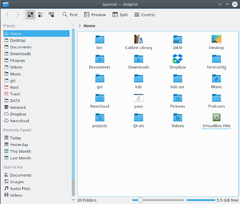
当我们从 Kickoff菜单里打开 Dolphin,它首先显示的是开始目录- 默认是 主文件夹。
你可以通过点击文件夹或文件来打开它们(这可以通过 → → 更改为双击打开(在更老的版本中,它位于 → → ))。
要选择和取消选择文件/文件夹,悬停鼠标指针到图标上,点击出现的+号来选择,点-号来取消选择。像是这样:
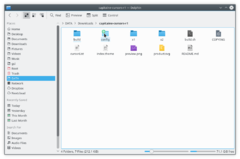
当你点击+号,文件/文件夹就会被选中。你可以用这种方法选定多个文件(鼠标拖拽矩形选择文件也是有效的)。你也可以用Ctrl + 单击一次一个的选定/取消选定,Shift + 单击来连续操作。
多个被选中的文件看起来是这样的:

创建新文件夹:你可以在当前活动的目录下用 → ,或快捷键 F10。
标签:Dolphin 支持多标签浏览。 举例来说,可以通过 → 打开一个新标签(如果您启用了菜单栏), 也可以通过 Ctrl + T 或鼠标中键点击文件夹图标和导航按钮(前进/后退)。
点击如何文件夹的时候都会默认启动 Dolphin。也能在 Kickoff 菜单里启动它.
用户界面
导航栏
Dolphin 整合了新概念以一种更快速和更准确的方法使用导航栏:新的面包屑(breadcrumb)导航栏。与传统的显示完整的路径不同,仅从「地址」之一开始的导航点作为按钮显示。点击那些按钮之一你能直接进入这个文件夹。通过这种方式你能快速的从一个子文件夹到达父文件夹。
在代表文件夹的按钮之间有一个小的箭头也是个可点击的按钮。点击这个箭头你能看到一份列表,列表里是跟你现在这个目录同级的所有子目录(译者注:这说的是你点当前这个文件夹按钮前的「箭头」的情况,其实列表显示的就是「箭头」前那个文件夹的所有子文件夹),使你能快速改变目录。
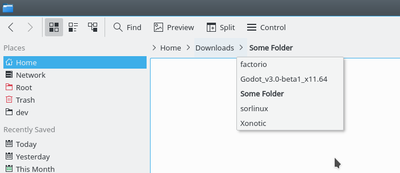
同样也有一个显示完整路径的经典导航栏。要使用此样式,您可以右键单击位置栏并选择。如果您希望位置栏可编辑,请触发键盘快捷键 Ctrl + L 或选择 → → 。通过单击面包屑样式中最后一个显示文件夹旁边的空间,您也可以切换到可编辑的位置栏。如果选择了可编辑样式,则会在位置栏的末尾显示一个复选标记。此复选标记是一个按钮,可用于更改回面包屑样式。当然也能用菜单和键盘快捷键。
拆分视图
Dolphin 能够拆分当前文件夹视图并产生出两个彼此相邻的文件夹视图,参考Midnight Commander 或 Krusader。这种浏览方式非常适合从一个文件夹复制或移动文件到另一个文件夹。
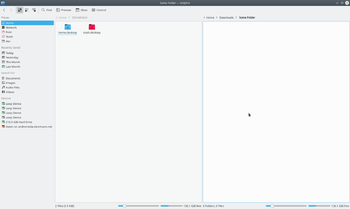
你能用 (键盘快捷键F3)拆分视图。要变回到只有一个文件夹视图,你可以点。小图标会显示哪个视图会被关闭。取决于当前激活的视图,减号会显示在图标的左侧或右侧。激活的视图会被关闭。如果你想用键盘快捷键操作的话,需要知道这点。在工具栏上也有一个用来拆分和关闭视图按钮。这个按钮也会显示减号,所以很容易的能看出来哪个视图会被关闭。
当然每个视图都有他自己的导航栏,每个视图也能用不同的视图模式。
Sorting Files
默认在现在选择的文件夹内的文件是依字母顺序排序。通过菜单修改排序方式。提供如下的排序条件:
Files may be sorted by the following attributes
- 名字
- 大小
- 日期
- 权限
- 拥有者
- 群组
- 类型
- Link Destination
- 路径
此外排序序列可以用定义,或 。
The sorting method can be changed by selecting from the toolbar and then select or . Additionally you may choose whether folders should be listed first by selecting .
视图模式
Dolphin features three different folder view modes:
 Icons shows each file or folder as an icon with its name
Icons shows each file or folder as an icon with its name
 Compact is the same as icons, but in a more compact form, allowing more folders and files to be displayed at once
Compact is the same as icons, but in a more compact form, allowing more folders and files to be displayed at once
 Details presents a list of files and folders, giving information on each, including but not limited to size and date
Details presents a list of files and folders, giving information on each, including but not limited to size and date
The mode can be changed from within Dolphin
- Select from the menu. This option is only available if the main Menubar is enabled
- Select from the menu. This option is only available when the main Menubar is disabled
- By selecting the appropriate icon from the main toolbar, if it is enabled
- Using the default keyboard shortcuts:
- Ctrl+1 switches to the Icon display mode,
- Ctrl+2 switches to Compact and,
- Ctrl+3 switches to Detailed view.
View as Icons
在"图标"视图模式下每个文件和每个文件夹都用一个图标表示。也可以显示文件的缩略图取代显示图标。这种做法可以通过菜单或是通过工具栏按钮开启/关闭。文件预览是有大小限制。这个大小限制可以在选项自定义。这里也有选项在预览时使用嵌入到文件里的缩略图(比如说mp3文件里的专辑封面)。KDE 4.5中预览通过选项开启、配置。
Dolphin 能够在图标下显示额外的信息。这些信息可以通过启用/关闭。主要来说可以选择的都是能作为排序条件的信息。
你能给图标分组来达到更好的预览效果。这个通过启用。现在这些图标都被分组,组和组又被一条以组名为标题的水平线划分开。分组是依据选择的排序方式里的排序条件。
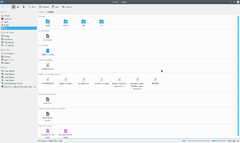
细节
"细节"视图模式下对比"图标"视图模式默认会显示许多额外的信息。所有文件都列在一个表格内。表头的关联菜单能够添加额外的列。可用的列如下:
- 大小
- 日期
- 权限
- 拥有者
- 群组
- 类型
- Link Destination
- Path
分列 "名称" 总是显示的。点击每个分列的顶部,列表会根据这个分列重新排序。点击分列顶部,分类序列会复原(译者注:靠(#‵′) 为什么我这不会恢复,只会反向再排序一次)。
自从KDE 4.1后Dolphin能够树形展开显示文件夹。在这种模式下,一个加号的标记符号会在文件夹旁显示。点击标记符号,文件夹就会被展开,所有包含的子文件夹和文件也会显示在列表but they are itenuated.点击标记符号后标记符号会变成减号,再次点击,展开就会被关闭。当然多少的文件夹都能用树形结构。树形视图默认是没启用,可以通过 打开选项启用。
设置所有文件夹默认的视图属性
在菜单项,你能为所有的文件夹浏览设置默认的任何属性。
Under → (or under the menu item → if you have enabled menu bar) you can set any of these attributes to be the default for all folder views.
面板
Dolphin 包含了多个面板,能通过菜单激活。每个面板都能放到左侧或右侧dock区域。要移动面板你必须点击面板顶部然后拖放面板。释放鼠标将被放置面板的那个区域会被高亮。面板可以堆叠在其他面板之上。在这种情况下,面板会放入分页标签。
在每个面板的标题有两个按钮。接近标题的按钮可以游离(undock)面板。这使得面板成为一个独立的窗口「漂浮」于 Dolphin上。但窗口还是与 Dolphin结合的,不能在没有 Dolphin时显示,不能像普通窗口一样最小化。再次点击按钮,面板可以回复停靠。第二个按钮会关闭面板。
非模态窗口(Non Modal Dialogs)
当移动,复制或删除文件/目录,这个对话框甚至会在操作还没完成的时就消失不见。然后一个进度条便出现在屏幕右下角,之后也会消失,如果你想要查看进度你需要点击系统托盘里的一个小的「i」信息图标。
地址
Dolphin 包含了一种被叫做"地址"的书签。通过(键盘快捷键F9)激活显示在一个面板内。地址的内容跟K菜单 Kickoff菜单 中的"计算机"目录一样。
点击地址中一个,他就会在当前文件夹视图内打开。右键关联菜单能够编辑「地址」或再次删除它们。同样能临时隐藏个别的条目。
文件夹的关联菜单能用来添加这个文件夹作为一个条目到「地址」面板,有个菜单项是。你也能拖放一个文件夹到「地址」面板。
地址面板也包含了链接到可移动设备比如USB-keys或CD的条目。如果设备被挂载会显示一个小的「插头图标指示」。关联菜单能够卸载这个设备。
「地址」被使用作为「面包屑导航栏」中的基础,导航栏中显示的地址,起点就是「地址」中与其有关的最近的父文件夹。
信息
信息面板能通过 (键盘快捷键F11)激活。这个面板显示了当前选择的文件/文件夹或是鼠标光标悬停的文件/文件夹的预览或是图标。一些额外的信息像是文件/文件夹的修改日期或是大小也会同时显示。
信息面板提供了给文件评星级,添加注释或标记文件的可能性。这是为桌面提供语义网络特性的语义桌面Nepomuk的一种界面。自KDE 4.2后,可以通过搜索「标记」(tags)搜索语义链接。现在的「标记」(tags)仅给了对未来版本的一个展望。
文件夹
一个提供文件系统的树形结构的面板能通过 (键盘快捷键F7)显示出来。树形结构提供了这样的可能性,点击+和-符号来展开/折叠子文件夹。点击其中之一的文件夹,文件夹的内容就会在当前视图打开。
Terminal
终端模拟器 Konsole 可以直接在 Dolphin 里显示,点击 (键盘快捷键F4)。所以在Dolphin里能直接使用shell命令。这个终端是在当前浏览的文件夹中打开的。Shift + F4 快捷键在新窗口打开 Konsole。
书签和地址
KDE3下你能在 Konqueror 里创建书签,但是他们对其他任何程序都没用。KDE SC 4.x 有着长足的进步变得更灵活了 - 但也不可避免的更复杂了。实际上KDE SC 4有三种类型的'书签',需要区别开来。他们属于不同的文件,各有不同的功能。
KDE Plasma offers two different systems of user-based links to different locations in the file system. One is called Places and the other one is called Bookmarks. They reside in different files, and have different functions. This offers more flexibility, however, it makes it necessary to learn the differences.
首先,有一种只有 Konqueror 能用的书签-web 书签。这些都保存在~/.kde/share/apps/konqueror/bookmarks.xml。其次有一种在Dolphin里叫做地址的书签。这种包括了 Dolphin文件管理器在内的所有程序都能用到。每次你用 你就会看到这种类型的书签。第三种书签是 程序书签 。那些书签共享一个文件,而与设置他们的程序无关,对所有程序都可用。随后有更详细的。
Places in applications
"地址"-全系统的导航
这里是一组默认的 地址项 -
- 主文件夹
- 网络
- 根
- 回收站
但你能添加其他地址。在 Dolphin 里,右击一个文件夹并选择。
默认"地址"就在所有程序里可见。如果你想要让他限制在 Dolphin 内,你需要右击地址列表里的新名称,那你会找到编辑他的选项。有个复选框。
如果你读取 ~/.kde4/share/apps/kfileplaces/bookmarks.xml 文件你会看到这个命令的处理结果。
在有些程序的文件菜单里也有选项添加文件夹到地址。眼下,然而,程序在哪些功能可用上不一样。要记住重要的事情是默认情况下地址项目对所有程序可用的是在 对话框。
限制在某个程序内
一些程序允许你编辑地址菜单中的项目。例如,如果在Gwenview,你右击地址中的文件夹,你可以设置选项成。
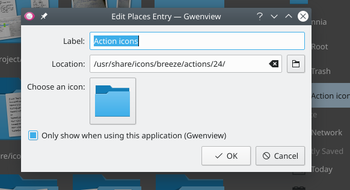
如果你需要限制在的程序还不允许你那样做的话,剩下唯一的方法是编辑这文件 ~/.kde4/share/apps/kfileplaces/bookmarks.xml。你需要直接添加这行<OnlyInApp>appname</OnlyInApp>到</metadata>标记上面。
程序中的书签
启用书签
在大多数发行版这种书签默认情况下没启用。要使用书签我们首先必须启用他们。打开一个文件 > 在KDE程序选择打开,你会看到,在图标面板的右侧区域,有一个扳手。从下拉列表中选择。
Using bookmarks
这是第三种类型的书签。还记得打开 使用的扳手图标吗?在他旁边有一个黄色的星星。这就是 书签管理菜单 。
这里你能定义书签,这书签在任何程序中同一菜单里都是可见的。他们存储在一个文件内,~/.kde4/share/apps/kfile/bookmarks.xml,他被拥有所有那种菜单的所有程序使用。
Dolphin 的压缩管理
现在管理压缩很容易的。 Dolphin里任何的目录下,选择高亮你想要压缩的文件,右击。然后用压缩选项,你能创建RAR压缩包,Gzipper tar压缩包,或是定义另一个你建立好的压缩模式。
类似的,如果你右击一个现有的压缩文件,你会看到添加在右击菜单里的一系列动作。你能解压这个压缩包的内容到当前文件夹,到自动判定的子文件夹或是到另一个你选择的地方。
若你要添加文件到现有的压缩包,你可以选择。
更多酷的操作
实时改变一个文件关联
是否曾经发生过你想打开一个文件却发现他与一个并非你想要的程序关联着?你可以,当然,用修改。但Dolphin'和Konqueror提供给你一个快速,相当酷的改变单一关联的方法。
Have you ever wanted to open a file, only to find that it is associated with an application that is not of your choice?
You can, for one, alter this in → → → → . This is the same as running kcmshell5 filetypes in a Konsole.
Alternatively, if you want to change multiple associations right quick, you would edit the *.desktop file directly, e.g. the file /usr/share/applications/org.gnome.Builder.desktop. For example, Gnome Builder associates with a great number of file-types which may not be desirable. So the line
MimeType=application/javascript; # we do not want all of these ....
may be shortened or commented out with # . Maybe a line
InitialPreference=2 X-KDE-InitialPreference=3
in the builder.desktop file helps to keep your previous default associated app, with builder being only secondary or tertiary option.
Type: XML document
在同级,右侧,有个「扳手」图标。点击图标,你可以添加或改变一个关联。
类似的,对于文件夹,你可以修改默认的文件管理器为(或非)Konqueror,你也可以选择,或添加另一个图片浏览器为可用的关联。
动作子菜单
子菜单为 Dolphin 带来了很多很酷的东西%>_<%。一些可选项只在你选择适用的文件时出现。部分选项如下
- 转换图片文件到另一种格式
- 预览文件
- 用KGet下载远程文件
- 依据安装的加密软件签名和/或加密文件
转录和拷贝音频CD音轨
- 插入音频 CD
- Dolphin 里进入这张 CD:他必定会作为「标卷」的形式出现在你的 Dolphin「地址」里或你能在地址栏上输入 audiocd:/ 进入。
现在你注意到 Dolphin提供每个音轨的 WAV 文件外,再加上:
- CDA 文件夹,以常见的CDA格式保存了索引信息。
- 整张 CD 的文件夹,将全部音轨以每种格式(.cda,.flac,.mp3,.ogg,.wav)各保存一份文件,各个文件格式不同,但都覆盖了全部音轨。
- FLAC 文件夹,包含了翻录成FLAC格式(无损信息格式)的音轨
- 包含了 CDDB 信息的 Information 文件夹
- MP3 文件夹,包含了以 MP3 格式存储的所有音轨
- Ogg 文件夹,包含了翻录成 OGG 格式的音轨。
然后你仅仅只需要复制喜欢的格式的那个文件夹,就获得你那张CD对应的转录版本!
Using timeline to have your recent files as startup folder
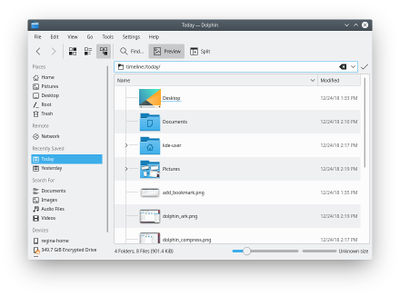
You can start up dolphin (with baloo up and running) with a view of recently modified files: Just navigate to the address/location of timeline:/today/ (copy paste it to the address bar) or use it as dolphin start-up-folder in dolphin-settings.


